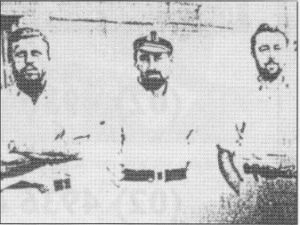- Author
- Spencer, Mark
- Subjects
- History - WW1
- Tags
-
- RAN Ships
- HMAS AE2
- Publication
- September 1999 edition of the Naval Historical Review (all rights reserved)
The friendship between Turkey and Australia was strengthened by the incongruous conflict between these two nations during the so called “Great War” of 1914-1918. This of course, was not a battle over territory or ethnic difference. There was no historical reason to cause one party to hate the other. The Turks were defending their territory. The Australian and New Zealand Army Corps (Anzacs) that stormed the beaches at the Gallipoli Peninsula were there for a specific goal, to disable the forts and gun batteries alongside the Dardanelles Strait. This would allow the passage of allied British and French ships into the Sea of Marmara with the ultimate goal of besieging Istanbul. It was hoped that removing Turkey from the war would ease the pressure on Russia, which in turn would greatly assist ending the war with Germany.
Turkey proved itself a stubborn and courageous fighter. The Dardanelles Campaign and the associated Gallipoli infantry campaign was a disastrous failure. Many British and allied ships were sunk in their efforts to penetrate the Dardanelles. The submarine, a relatively new machine in warfare, was considered to be the only hope. But the Dardanelles Strait was 64 kilometres long, had currents reaching 4 knots for the submarines to push against, was narrow and posed difficult navigational hazards, and was carefully guarded with forts and gun-boats, floating and fixed minefields, and nets. No enemy craft had traversed the Dardanelles passage for over five hundred years, and many had tried! After unsuccessful attempts by both British and French submarines, Australia’s only submarine, the AE2 (who had a sister submarine the AE1, which was mysteriously lost off New Guinea with all hands), was given the chance – and succeeded!

The story of the AE2‘s harrowing passage through the strait in the early morning hours of April 25 (the same day that troops landed on the beaches at Gallipoli – ‘Anzac Day’), as told by its Irish commander Henry Stoker in his later book “Straws in the Wind”, was the stuff of a great feature film. She literally scraped along the wires holding the floating mines laid at the surface, three times dragging something heavy along her hull to the stern.
Mines that miraculously did not detonate? Having extricated herself from that predicament, she then beached herself high and dry twice at the dog-leg turn in the Dardanelles passage known as the “Narrows” where the city of Çanakkale sits. Both these course deviations resulted in her being beached and well exposed right under the foundations of Turkish forts. So close was the submarine to the forts on both occasions that the Turks could not depress the guns enough to hit their target! It took four and five agonising minutes consecutively for the AE2 to wriggle herself back into deeper water and continue her course.
Then, on her way along the straight part of the passage into the Sea of Marmara, she nearly suffered irreparable damage forcing her to lie on the bottom for 13 hours. At the end of this time the stale air, which would not allow a match to be ignited, could barely sustain life. Eventually, the AE2 entered the wider Sea of Marmara and created general havoc for a further five days. She telegraphed the news of her success to HMS Queen Elizabeth and this convinced the allied navies that submarines could indeed negotiate the Dardanelles. Amongst those British E-class submarines that subsequently entered the Sea of Marmara and sank many Turkish and German naval craft were the E11 commanded by Martin Dunbar Nasmith and the E14 commanded by E.C. Boyle. News of the AE2‘s success reached the troops at Gallipoli and buoyed their hopes. Indeed, it is very probable that Sir Ian Hamilton’s decision not to re-embark the troops after the disastrous first day at Gallipoli was influenced by the AE2‘s success.
On April 30, the AE2, intending to rendezvous with Boyle’s E14 off Karaburun Point, hit a denser layer of water at such an angle that she surfaced unintentionally. Her exposure to the surface was ill timed, and after a dangerous series of yo-yo ascents and descents beyond her tested depth of 100 feet (30 metres), a Turkish gun-boat, the Sultanhisar was waiting for them to surface again. The Sultanhisar fired a torpedo at the AE2 which fortunately missed, but shell fire penetrated the pressure hull rendering the submarine useless. Twenty-nine ratings (half British, half Australian) and three British officers surrendered but not before Stoker sent the AE2 on her “last and deepest dive”.




